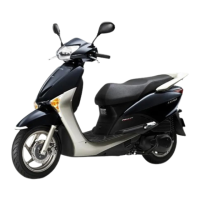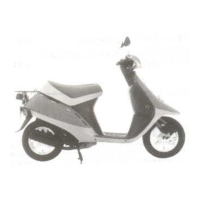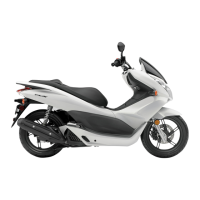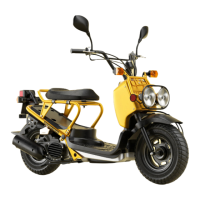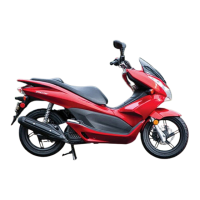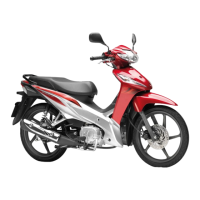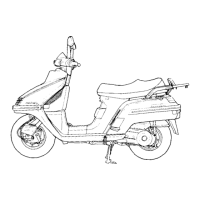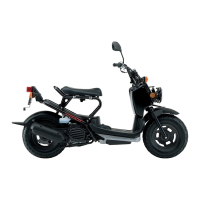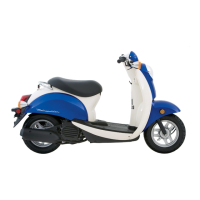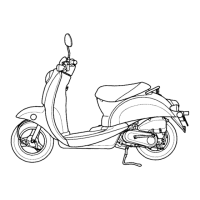Do you have a question about the Honda LEAD SCV100 and is the answer not in the manual?
Explains safety messages, signal words (DANGER, WARNING, CAUTION), and their meanings.
Advice on being visible to other drivers to prevent accidents.
Emphasizes not pushing limits and avoiding impairment from alcohol or drugs.
Warns against drinking alcohol and riding due to impaired judgment and reaction time.
Discusses the importance of helmets and face shields/goggles for protection.
Recommends sturdy boots, gloves, and bright/reflective clothing for rider safety.
Specifies the maximum weight capacity for the scooter and its compartments.
Provides advice on safely transporting passengers or cargo, including weight distribution.
Advises using genuine Honda accessories and checking for compatibility.
Warns against removing or modifying original parts, as it can affect safety and legality.
Explains the function of the scooter's instrument panel indicators.
Details the fuel gauge's operation and the meaning of the red band indicator.
Explains brake adjustment and free play maintenance for safe operation.
Information on the fuel tank capacity, location, and refueling procedure.
Advises on using alcohol-containing fuels and potential warranty issues.
Step-by-step guide to checking and maintaining the engine oil level.
Discusses engine oil grades, viscosity, and selection criteria based on temperature.
Detailed steps for draining engine oil, including torque specifications.
Importance of proper tyre pressure for handling, comfort, and safety.
How to inspect tyres for wear, damage, and foreign objects.
Explains how to check tyre tread depth using wear indicators.
Discusses whether to repair or replace punctured or damaged tyres.
Advises on using correct tyre sizes and ensuring proper balancing after replacement.
Details the function of the ignition switch and its key positions.
Explains how to operate the headlight dimmer for high and low beams.
Describes how to activate left and right turn signals and turn them off.
Explains how to use the horn button.
Instructions on how to lock the steering to prevent theft.
How to use the seat lock to open and secure the seat.
Instructions for using the helmet holder to secure a helmet while parked.
Information about the center compartment's capacity and usage.
Details the location and purpose of the document compartment.
Information on the luggage hook's location and weight limit.
Essential checks to perform before riding the scooter for safety.
Detailed steps on how to use the center stand.
Safety precautions to follow when performing maintenance tasks.
General safety warnings and precautions related to scooter operation and maintenance.
Outlines the recommended maintenance tasks at specific intervals.
Step-by-step instructions for removing the scooter battery.
Detailed steps for washing the scooter safely and effectively.
Advice on polishing, waxing, and touch-up paint after cleaning.
How to remove road salt to prevent corrosion.
Detailed engine specifications like bore, stroke, displacement, and spark plug gap.
Specifications related to chassis geometry and suspension components.
Specifications for the primary and final drive reduction ratios.
Specifications for the battery, generator, lights, and fuses.
Explains safety messages, signal words (DANGER, WARNING, CAUTION), and their meanings.
Advice on being visible to other drivers to prevent accidents.
Emphasizes not pushing limits and avoiding impairment from alcohol or drugs.
Warns against drinking alcohol and riding due to impaired judgment and reaction time.
Discusses the importance of helmets and face shields/goggles for protection.
Recommends sturdy boots, gloves, and bright/reflective clothing for rider safety.
Specifies the maximum weight capacity for the scooter and its compartments.
Provides advice on safely transporting passengers or cargo, including weight distribution.
Advises using genuine Honda accessories and checking for compatibility.
Warns against removing or modifying original parts, as it can affect safety and legality.
Explains the function of the scooter's instrument panel indicators.
Details the fuel gauge's operation and the meaning of the red band indicator.
Explains brake adjustment and free play maintenance for safe operation.
Information on the fuel tank capacity, location, and refueling procedure.
Advises on using alcohol-containing fuels and potential warranty issues.
Step-by-step guide to checking and maintaining the engine oil level.
Discusses engine oil grades, viscosity, and selection criteria based on temperature.
Detailed steps for draining engine oil, including torque specifications.
Importance of proper tyre pressure for handling, comfort, and safety.
How to inspect tyres for wear, damage, and foreign objects.
Explains how to check tyre tread depth using wear indicators.
Discusses whether to repair or replace punctured or damaged tyres.
Advises on using correct tyre sizes and ensuring proper balancing after replacement.
Details the function of the ignition switch and its key positions.
Explains how to operate the headlight dimmer for high and low beams.
Describes how to activate left and right turn signals and turn them off.
Explains how to use the horn button.
Instructions on how to lock the steering to prevent theft.
How to use the seat lock to open and secure the seat.
Instructions for using the helmet holder to secure a helmet while parked.
Information about the center compartment's capacity and usage.
Details the location and purpose of the document compartment.
Information on the luggage hook's location and weight limit.
Essential checks to perform before riding the scooter for safety.
Detailed steps on how to use the center stand.
Safety precautions to follow when performing maintenance tasks.
General safety warnings and precautions related to scooter operation and maintenance.
Outlines the recommended maintenance tasks at specific intervals.
Step-by-step instructions for removing the scooter battery.
Detailed steps for washing the scooter safely and effectively.
Advice on polishing, waxing, and touch-up paint after cleaning.
How to remove road salt to prevent corrosion.
Detailed engine specifications like bore, stroke, displacement, and spark plug gap.
Specifications related to chassis geometry and suspension components.
Specifications for the primary and final drive reduction ratios.
Specifications for the battery, generator, lights, and fuses.
| Weight | 97 kg (Dry) |
|---|---|
| Front Suspension | Telescopic fork |
| Front Tire | 90/90-12 |
| Seat Height | 740 mm |
| Displacement | 102 cc |
| Brakes | Front: Disc, Rear: Drum |
| Bore x Stroke | 50.0 mm x 52.0 mm |
| Rear Suspension | Unit swing |
| Engine Type | Single-cylinder, 4-stroke, air-cooled |
